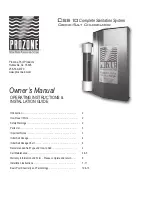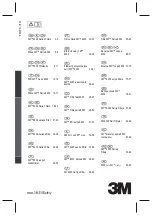
12
WATER CHEMISTRY
CHLORINE PRODUCTION AND CONTROL
Free Chlorine:
A ‘free’ Chlorine residual of 0.5ppm to 1.5ppm should be maintained at all times. This will vary only with respect to bathers in the
pool, debris falling into the pool, and the pools overall temperature. These factors will affect the demand for chlorine and also the water ‘balance’ and
‘filtration’ effectiveness (refer to the equipment manufactures specifications with regard to the maximum chlorine level permissible).
Testing for Chlorine:
Testing for Chlorine levels is very important and should be performed regularly by the pool owner, as well as a pool water
professional on a periodic basis.
Residual Water Test:
The sample of water to be tested should be taken at arms depth away from the pool returns. This will avoid highly chlorinated
water coming from the Salt Generator Cell, and ensures that the reading will be a true representation of the pool’s residual chlorine levels.
Production Water Test:
Testing for Chlorine production is performed by taking a sample directly at the pool return, which is water directly from the
Salt Generator Cell, and should indicate a higher chlorine level than the residual test showed.
BASIC POOL CHEMISTRY TERMINOLOGY
TDS – Total Dissolved Solids:
There may be other elements, in addition to salt, that may be present in the pool’s water. Your pool professional can
perform a TDS test and determine if there are other elements that may be harmful in the pool water as a result of adding salt.
Combined Chlorine vs. Free Chlorine:
Combined Chlorine, which include Chloramines, is a molecule of Chlorine that has attached to a contami-
nant in the pool water. It remains bound to it until it is the other is burned off through breakpoint chlorination (an unpleasant procedure) or ozonation.
Combined chlorines are most often associated with odors, eye irritation, and other unpleasant side effects of chlorination.
Installation of a Prozone Ozonator/Salt Generator System does away with breakpoint chlorination by
destroying the contaminant particles, and returning the Chlorine to the free state so that it is then able to keep
the pool clean, clear and pleasant to use.
The free Chlorine in your pool is the pure chlorine required to provide residual sanitation at all times and should ideally remain within the range
of .5 to 1.0ppm. This lower level of residual chlorine is possible because your Ozone system has the potential to oxidize and sanitize between
60% and 80% of all the contaminants in the pool’s water. Free chlorine provides a high level of sanitizing power and has no odor or irritating effects.
WATER BALANCE
The water balance of your pool is critical to monitor even after you have installed the CSS-10. There are three components to water balance: pH,
Total Alkalinity; and Calcium Hardness.
pH Level:
1. pH is a measure of how ‘acidic’ the water is in the pool .
2. pH is measured on a scale of zero (0) to 14 A level of 7 is considered neutral.
3. A level greater than 7 is considered alkaline solution, and a level less than 7 is considered acidic.
4. A high pH (above 7.8) begins to reduce the effectiveness of chlorine, and will potentially cause scale to appear as well as becoming an
irritant to swimmers.
5. A low pH (les than 7) may cause the water to become corrosive and damage the pools finish, the pool equipment (heat exchangers especially),
as well as becoming an irritant to swimmers.
6. Each type of pool and pool finish has a specific range in which the pH should remain. Generally, a pH of between 7.2 and 7.8 is suitable for
most pool types and optimum for bather comfort.
7. To lower pH, a diluted solution of Muriatic Acid is added to the pool.
8. To raise pH ,add sodium carbonate.































